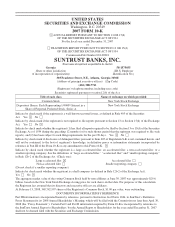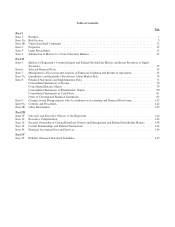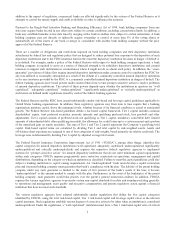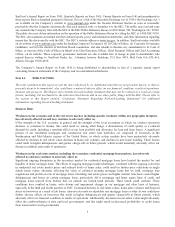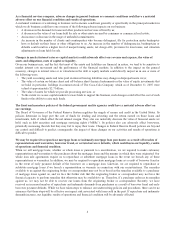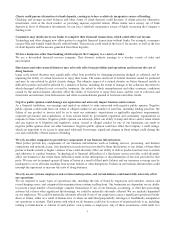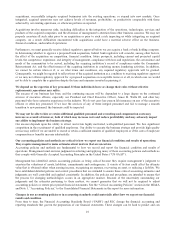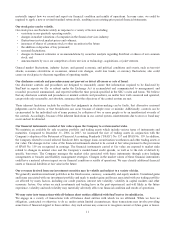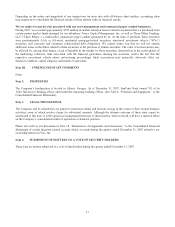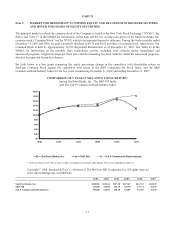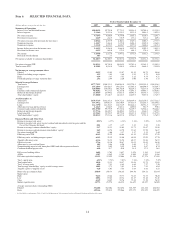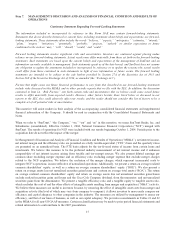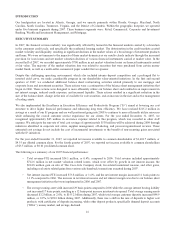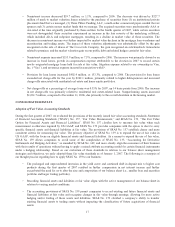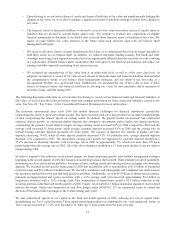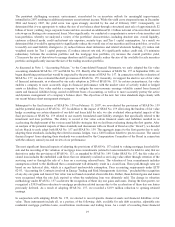SunTrust 2007 Annual Report Download - page 21
Download and view the complete annual report
Please find page 21 of the 2007 SunTrust annual report below. You can navigate through the pages in the report by either clicking on the pages listed below, or by using the keyword search tool below to find specific information within the annual report.or those new products may not achieve market acceptance. As a result, we could lose business, be forced to price products
and services on less advantageous terms to retain or attract clients, or be subject to cost increases.
The Parent Company’s ability to receive dividends from its subsidiaries accounts for most of its revenue and could
affect its liquidity and ability to pay dividends.
The Parent Company is a separate and distinct legal entity from its subsidiaries. It receives substantially all of its revenue
from dividends from its subsidiaries. These dividends are the principal source of funds to pay dividends on the Parent
Company’s common stock and interest and principal on its debt. Various federal and/or state laws and regulations limit the
amount of dividends that our bank and certain of its nonbank subsidiaries may pay to the Parent Company. Also, the Parent
Company’s right to participate in a distribution of assets upon a subsidiary’s liquidation or reorganization is subject to the
prior claims of the subsidiary’s creditors. Limitations on the Parent Company’s ability to receive dividends from its
subsidiaries could have a material adverse effect on the Parent Company’s liquidity and ability to pay dividends on common
stock. For more information, refer to the “Liquidity Risk” section in the MD&A and Note 14, “Capital,” to the Consolidated
Financial Statements.
Significant legal actions could subject us to substantial uninsured liabilities.
We are from time to time subject to claims related to our operations. These claims and legal actions, including supervisory
actions by our regulators, could involve large monetary claims and significant defense costs. Substantial legal liability or
significant regulatory action against us could have material adverse financial effects or cause significant reputational harm to
us, which in turn could seriously harm our business prospects. We may be exposed to substantial uninsured liabilities, which
could adversely affect our results of operations and financial condition.
Company Risks
Recently declining values of residential real estate may increase our credit losses, which would negatively affect our
financial results.
We offer a variety of secured loans, including commercial lines of credit, commercial term loans, real estate, construction,
home equity, consumer and other loans. Many of our loans are secured by real estate (both residential and commercial) in our
market area. A major change in the real estate market, such as deterioration in the value of this collateral, or in the local or
national economy, could adversely affect our customer’s ability to pay these loans, which in turn could impact us. Risk of
loan defaults and foreclosures are unavoidable in the banking industry, and we try to limit our exposure to this risk by
monitoring our extensions of credit carefully. We cannot fully eliminate credit risk, and as a result credit losses may occur in
the future.
Deteriorating credit quality, particularly in real estate loans, has adversely impacted us and may continue to
adversely impact us.
We have experienced a downturn in credit performance, particularly in the third and fourth quarters of 2007, and we expect
credit conditions and the performance of our loan portfolio to continue to deteriorate in the near term. This deterioration has
resulted in an increase in our loan loss reserves throughout 2007, which increases were driven primarily by residential real
estate and home equity portfolios. Additional increases in loan loss reserves may be necessary in the future. Deterioration in
the quality of our credit portfolio can have a material adverse effect on our capital, financial condition and results of
operations.
Disruptions in our ability to access global capital markets may negatively affect our capital resources and liquidity.
In managing our consolidated balance sheet, we depend on access to global capital markets to provide us with sufficient
capital resources and liquidity to meet our commitments and business needs, and to accommodate the transaction and cash
management needs of our customers. Other sources of funding available to us, and upon which we rely as regular
components of our liquidity risk management strategy, include inter-bank borrowings, repurchase agreements and
borrowings from the Federal Reserve discount window. Any occurrence that may limit our access to the capital markets,
such as a decline in the confidence of debt purchasers, our depositors or counterparties participating in the capital markets, or
a downgrade of our debt rating, may adversely affect our capital costs and our ability to raise capital and, in turn, our
liquidity.
We have in the past and may in the future pursue acquisitions, which could affect costs and from which we may not
be able to realize anticipated benefits.
We have historically pursued an acquisition strategy, and intend to continue to seek additional acquisition opportunities. We
may not be able to successfully identify suitable candidates, negotiate appropriate acquisition terms, complete proposed
9


